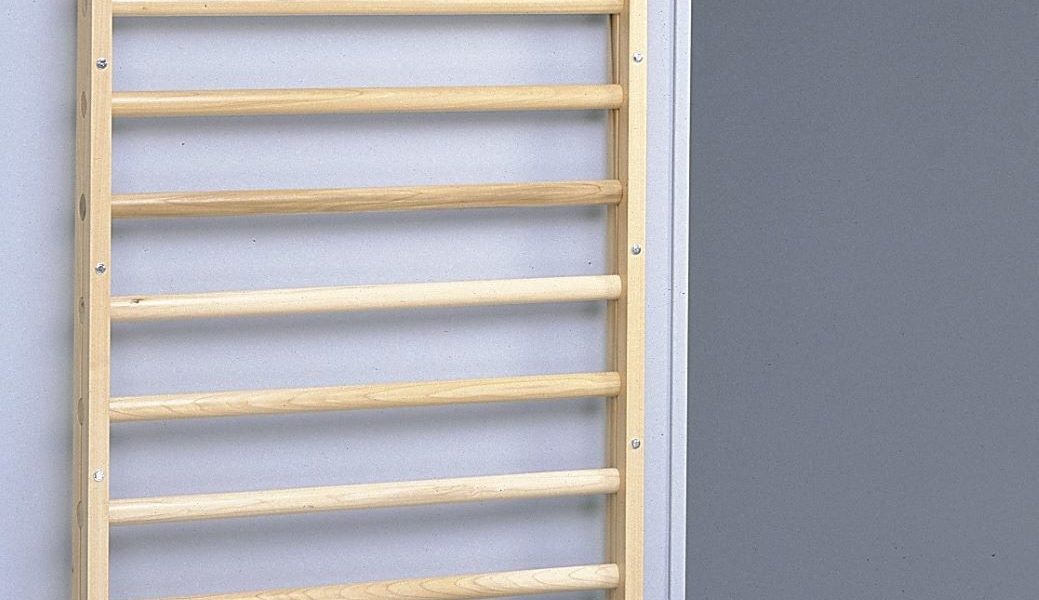By Brian Kolenich
Stall Bars as we know them today have a rich history.
They were pioneered in Sweden during the early 1800s by Per Henrik Ling, founder of the Swedish Royal Gymnastic Central Institute. He was also a pioneer of physiotherapy and gymnastics during this era.
Brought to America decades later as the Swedish Ladder, they were soon adapted for use in health clubs and school gymnasiums before 1900.
Promoted under the Swedish System of “medical gymnastics” by Baron Nils Posse, publisher of the 1894 Handbook of School Gymnastics, their use worldwide and in America grew throughout the 20th century.
Today, 200 years later, Stall Bars are used more widely than ever, and in many more ways. Specific fitness regimens, such as The Bar Method (which originated in San Francisco), require Stall Bars. Our standard Stall Bars are 94″ high and require an 8-foot minimum ceiling height.
Some Stall Bars, made exclusively with local native hardwoods, may be customized for height and width to suit your facility needs. You can also find custom finished versions to match interior designer requirements.
These wall mounted bars are often used with accessories, which broaden the applications for the bars. The most popular are the Stall Bar Bench and an Abdominal Board, which rests on the rungs.
Stall Bar fitness regimens using a bench include Pullbacks and Backbends. In today’s gymnasiums, the humble Stall Bar is also used in Crossfit and Yoga routines.
For school-age activities, here are the top 10 Stall Bar exercises:
(Courtesy of TumbleBear Connection)
- Hang in tuck, pike, straddle
- Tuck ups, pike ups, straddle ups
- Chin-up and pull-ups
- Face bars and place hands approximately waist high, step back, lean forward at 90 degrees with the floor, and stretch the upper back and shoulders as you press the chest towards the floor.
- Turn the student’s back is against the bars. Bend forward and hold onto the bars to stretch the hamstrings and hips, and relax the lower back.
- Stand perpendicular to the bars about 2′ from bars. Hold onto bar with the closest hand and stretch away from the bars. Lean inwards towards the bars creating a rainbow leaning in towards the bars to stretch the laterals and sides of the body.
- Hang with back against the bars and legs over a barrel. Roll out until the body is in a hollow, tight position and roll back in pulling and tightening the core.
- Long hang and swing legs in dual windshield washer movements.
- Bridge with feet facing bars. Arch up and walk feet up to kickover.
- Super splits: Place foot on lowest rung and over split. Continue moving up a rung at a time and go further in over split.
A key exercise area for Stall Bars are simple bodyweight exercises. They are used for climbing and coordination skills, particularly in primary school education.
They are used by advanced gymnasts for resistance training, flexibility training or abdominal exercises. Gymnasts can hang from a higher overhung bar with their back facing the bar (using body weight) and perform abdominal exercises and chin-ups, or hang facing the bar to stretch their back.
This top bar is often extended further than the other bars, to facilitate exercises where the user hangs vertically.
Yoga practitioners can use Stall Bars to elevate their routines. For example, there are stall bar yoga poses that can’t simply be performed on the ground. These can help to fill strength and mobility gaps.
CrossFit athletes can make great use of Stall Bars, such as improving isometric strength (like flagpole poses), and Stall Bars are also a great tool for plyometric and bodyweight exercises often featured in CrossFit workouts.
Strength athletes can use Stall Bars to supplement traditional weight training. For instance, by placing your feet at different heights on the rungs, you can ramp up the intensity of pushups.
Are these Stall Bars easy to install, or suitable for your wall? A block or brick wall is ideal, but a metal or wood stud hollow wall would work with proper bracing and installation. Installation by a professional is highly suggested.
In a gymnasium setting, Stall Bars, which are commonly 36″ wide, may be “ganged” together to form a Dual or Triple arrangement, or a continuous wall of bars.
What qualities should you look for in a new set of stall bars? This depends on your budget, as well as both form and function.
The most versatile Stall Bar, that is also durable and cost-effective, is made with 100% North American hardwoods. This allows easy modifications at installation, and customization by the factory to suit your layout.
If extreme weight capacity or outdoor use is required, there are versions on the market with metal rungs and/or metal side rails which are suitable.
On the important subject of Stall Bar rungs, Bailey Stall Bars utilize a special oval shaped rung. This feature feels better to the grip and does not rotate in use.
Rungs on most bars are round, which requires a nail or screw be installed into the rung to prevent rotation. This could promote cracking of the rung under stress. Of course, metal rungs eliminate this issue, but also feel cold to the touch.
One feature to avoid are imported Stall Bars made with tropical hardwoods, such as Eucalyptus wood, which are prone to cracking if not properly cut or handled, or tend to decay if not stored in the correct conditions. When shopping for Stall Bars, check the specifications carefully.
In summary, Stall Bars are a worthwhile long-term investment for any facility that desires to offer a wide range of activities to clients or students.
Centuries of development and verified benefits leave no doubt as to their effectiveness in the rehabilitation and improvement of the human body.
Brian Kolenich began working with medical equipment in 1978 and has been with Bailey Manufacturing Company since 1996. He covers product development, market research and business development. Bailey Manufacturing makes physical therapy, occupational therapy and sports medicine products in the size and color that fits your need, www.baileymfg.com.












